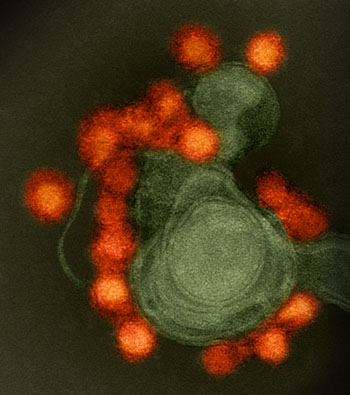Biological Link Found between Zika Infection and Guillain-Barré Syndrome
By LabMedica International staff writers
Posted on 19 Oct 2016
Guillain-Barré is a very rare but potentially paralyzing disorder of the nervous system that appears days to weeks after infection with viruses or bacteria.Posted on 19 Oct 2016
A so-called post-infectious immune condition, it occurs when a person’s own immune system attacks the myelin sheaths that protect the body’s nerve cells, often resulting in muscle weakness, pain, sensory deficiencies and, in very acute cases, paralysis.

Image: A transmission electron microscope (TEM) image of negative-stained, Fortaleza-strain Zika virus (red), isolated from a microcephaly case (Photo courtesy of the NIAID).
An international team of scientists led by those at Johns Hopkins Medicine (Baltimore, MD, USA) evaluated prospectively patients with suspected neurological problems associated with Zika and provided tools for viral tests of blood, cerebrospinal fluid (CSF) and urine samples from 68 people with symptoms of Guillain-Barré. Of the 68 patients initially evaluated in Colombia, virus and immunology studies were conducted using the body fluids from 42. After some evaluation, the team found urine to be the most reliable fluid to diagnose Zika infection in patients with Guillain-Barré.
Virological testing was performed at the Virology Laboratory, Universidad del Valle, Cali, Colombia). The TaqMan real-time polymerase chain reaction (RT-PCR) assay used for the diagnosis of Zika virus (ZIKV) infection was based on a published protocol. Serum, CSF, and urine were considered to be positive for ZIKV if the two distinct genomic regions targeted by the RT-PCR were amplified. Serum and CSF samples were also tested for the four Dengue virus (DENV) serotypes by means of nested RT-PCR. DENV immunoglobulin M (IgM)-capture and IgG-capture enzyme-linked immunosorbent assays (ELISAs) (Panbio Diagnostics, Waltham, MA, USA) were performed to detect the presence of flavivirus cross-reactive antibodies.
The team reported that 17 patients tested positive for Zika virus in their urine. Another 18 had no evidence of Zika virus in urine but showed the immunologic footprints of Zika infection through the presence of virus-specific antibodies in their blood or spinal fluid. Most of the patients were adults, 38 were males, and 30 were females of a mean age of 47 years old. Almost all patients displayed two or more clinical symptoms of Zika infection, which include fever, headache, rash and conjunctivitis. Tests also revealed that most of the 46 patients whose Guillain-Barré was confirmed by electrodiagnostic neurological tests had the acute inflammatory demyelinating polyneuropathy variant of the disorder. This type of Guillain-Barré attacks the myelin, a protective group of cells that insulates the surface of the nerve fibers.
Carlos A. Pardo, MD, an associate professor of neurology and pathology and senior author of the study, said, “At the beginning of the Zika outbreak in South America, my colleagues in Colombia contacted me with concern about the increasing number of patients with neurological complications in their hospitals.” He cautions that although the study demonstrates a biological and viral association between Zika infection and Guillain-Barré, it does not reveal the biological mechanisms through which Zika might initiate an immune attack on the nerves. The study was published on October 5, 2016, in The New England Journal of Medicine.
Related Links:
Johns Hopkins Medicine
Universidad del Valle
Panbio Diagnostics








 (3) (1).png)




